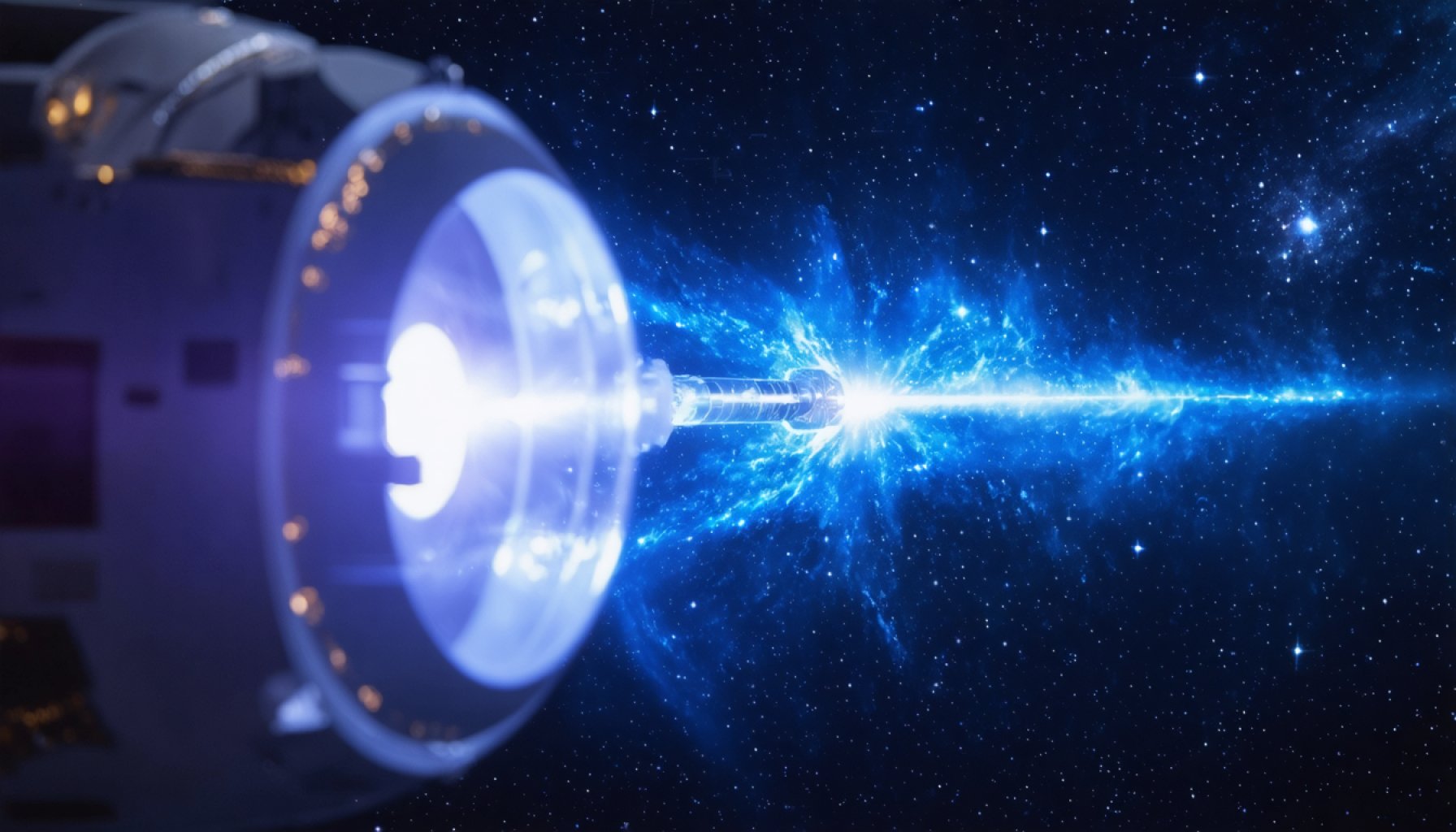- NASA’s Psyche spacecraft successfully transmitted a laser message over 16 million kilometers to Earth, marking a milestone in the Deep Space Optical Communications Experiment (DSOC).
- This achievement advances the shift to optical communication, enabling faster data transmission—up to 100 times faster than radio waves—for deep-space missions.
- On an extraordinary day in November 2023, Psyche’s laser communication accurately reached its target, the Hale Telescope in California, despite immense cosmic distances.
- The successful test highlights the potential for real-time data exchanges and interactive space exploration, crucial for upcoming missions to Mars and beyond.
- The laser communication milestone opens possibilities for high-resolution imagery, live streaming from distant planets, and quicker scientific analysis.
- NASA’s achievement underscores the relentless human pursuit of knowledge and the dawn of enhanced celestial connectivity.
As the sun sets beyond the telescopes of Palomar Observatory, a beam of light pierces the void, a herald of a revolutionary era. NASA’s Psyche spacecraft, still on its journey to a distant asteroid, recently achieved a breathtaking first: transmitting a laser-based message over 16 million kilometers to Earth. This historic feat, part of the Deep Space Optical Communications Experiment (DSOC), opens a new chapter in the cosmic narrative, one marked by dazzling speed and robust data streams.
Psyche’s Voyage: More Than a Journey
Propelled by the mighty engines of a SpaceX Falcon Heavy, Psyche was launched from Earth in October 2023. Although its primary mission lies in unraveling the mysteries of a metal-rich asteroid between Mars and Jupiter, Psyche has already etched its name in the annals of technological milestones. Imagine phoning home from a world away; radio waves, our traditional means of cosmic chatter, are no longer enough for our bandwidth-hungry era. Enter the era of optical communication, where near-infrared lasers paint the sky with information, reaching speeds 10 to 100 times faster than their predecessors.
This thrilling capability could redefine our engagement with deep-space missions, making real-time data exchanges, high-resolution imagery, and even live video from planets thousands of miles away a reality.
Hitting a Galactic Bullseye
On an extraordinary November day in 2023, a coded laser message from Psyche met its target, the Hale Telescope in California, with impeccable accuracy. This task might seem simple at a glance, but it is akin to threading a needle from another world. Achieving precision at such cosmic distances—where light itself takes about 50 seconds to arrive—is an art form. It necessitated advanced alignment systems to secure the laser’s focus amidst the chaos of celestial mechanics and Earth’s movements.
Laser communication narrows data into finely tuned packets, vastly outperforming radio frequencies by managing the deluge of information that modern space missions yield. It is a testament to human ingenuity and meticulous engineering.
The Dawn of Enhanced Exploration
Psyche’s triumphant test isn’t just about technological prowess; it ushers in a forthcoming epoch of space exploration expansion. As we cast our ambitions toward Mars, and eventually toward the uncharted realms beyond our solar system, swift and voluminous communication becomes a lynchpin. Crewed missions could transform from isolated adventures to highly interactive voyages, with astronauts able to virtually connect with Earth in real time. Unmanned explorations would benefit equally, speeding up scientific scrutiny and fostering prompt reaction capabilities.
When Psyche reaches its asteroid target in 2028, its mission promises not only technological triumph but scientific enlightenment. The asteroid, believed to be the exposed core of an ancient planetesimal, offers a rare vista into the primordial processes that molded our planetary neighborhood. Through extensive analysis of this relic, scientists hope to uncover how rocky planets, including Earth, developed their cores billions of years ago.
A New Era of Celestial Connectivity
With this unprecedented laser communication achievement, NASA etches another milestone in the epic of human exploration. The implications of DSOC’s success surge across possibilities. From astronauts potentially live-streaming as they explore the Martian surface to probes dispatching ultra-HD visuals from distant planetary bodies, a laser-powered future looms bright on the horizon.
In our relentless pursuit of knowledge across the universe, NASA reaffirms that even in the vast abyss of space, the light of human ingenuity cannot be dimmed. This leap, powered by lasers, embodies the persistent spirit of discovery guiding us to new cosmic shores.
Revolutionizing Space Communication: How NASA’s Psyche Mission Sets New Standards
Understanding Psyche’s Mission and Its Impact
NASA’s Psyche mission is a paradigm of cutting-edge space exploration. Propelled by a SpaceX Falcon Heavy rocket, the Psyche spacecraft is not just traveling to unfold the mysteries of a metal-rich asteroid located between Mars and Jupiter. It stands at the forefront of a transformation in how we might communicate across the vast expanse of space. This mission integrates the Deep Space Optical Communications Experiment (DSOC), marking a significant breakthrough in the realm of space communications.
Laser Communication: The Future of Space Exploration
How Laser Communication Works
Laser communication, or optical communication, uses near-infrared lasers to send data between spacecraft and Earth at unprecedented speeds. Unlike traditional radio waves, which are susceptible to interference and limited data transmission rates, lasers concentrate data into narrow, precisely aimed beams. This method reduces interference and enables faster data transfer rates, potentially 10 to 100 times quicker than current radio technologies.
Real-World Use Cases
1. Enhanced Real-Time Communications: With lasers, astronauts could communicate with mission control almost in real-time, even from Mars.
2. Superior Data Transmission: Spacecraft can send high-resolution images and even live video back to Earth, vastly improving our ability to study other worlds.
3. Faster Scientific Analysis: Faster data rates mean faster access to scientific data, accelerating our understanding of outer space.
Psyche’s Milestone Test: A New Communication Era
Achievements of the DSOC Experiment
In November 2023, a laser message transmitted from Psyche was successfully received by the Hale Telescope in California. Reaching Earth over a distance of 16 million kilometers, this feat required incredible precision. This successful test heralds a new era where future deep-space missions could benefit from laser communications’ high speed and reliability.
Challenges and Limitations
While promising, laser communication faces significant challenges:
– Atmospheric Interference: Earth’s atmosphere can scatter laser beams, complicating reception of signals.
– Alignment Precision: Requires extreme precision to maintain laser alignment over vast distances.
Industry Trends and Predictions
1. Rapid Adoption in Future Missions: Expect NASA and other space agencies to integrate laser communication in future missions to build on this success.
2. Commercial Space Ventures: Private space companies may adopt optical communications to improve their own missions’ capabilities.
Pros and Cons Overview
Pros
– Higher Data Rates: Essential for streaming high-resolution images and videos back to Earth.
– Lower Power Requirements: Lasers require less power than equivalent radio systems for similar data rates.
– Reduced Bandwidth Usage: More efficient use of communication bandwidth compared to radio waves.
Cons
– Precision Needs: Alignment must be exact, demanding advanced technology and control systems.
Security and Sustainability
Laser communications can potentially offer more secure transmission channels than traditional radio communications. As the technology matures, it’s essential to consider its sustainability by evaluating its energy consumption and impacts on space and Earth-based systems.
Conclusion: Looking Ahead
Psyche’s journey emphasizes the importance of advancing communication technology to facilitate deeper space exploration. Future missions will increasingly rely on optical communications to maintain robust links with Earth.
Actionable Recommendations
1. Stay Informed: Follow updates from NASA on future deep-space mission technologies.
2. Explore New Technologies: For those in the aerospace sector, invest in R&D for optical communication systems.
3. Engage with Community: Participate in forums and discussions about the implications of new space technologies.
For further information, explore NASA to understand more about their missions and innovative technologies leading the space exploration frontier.














